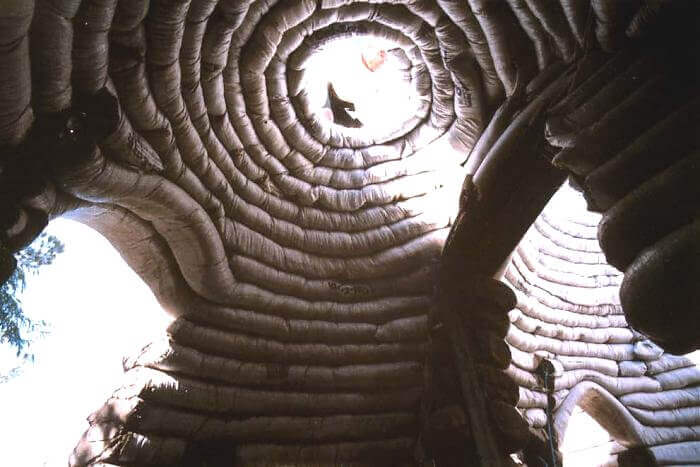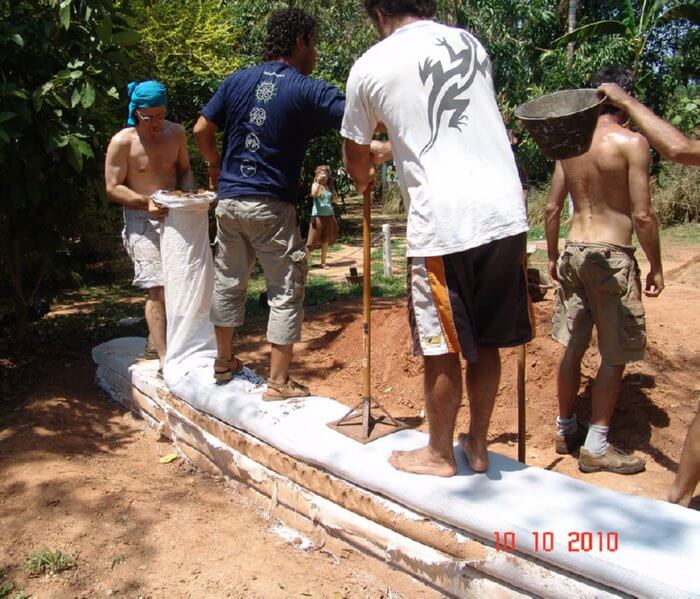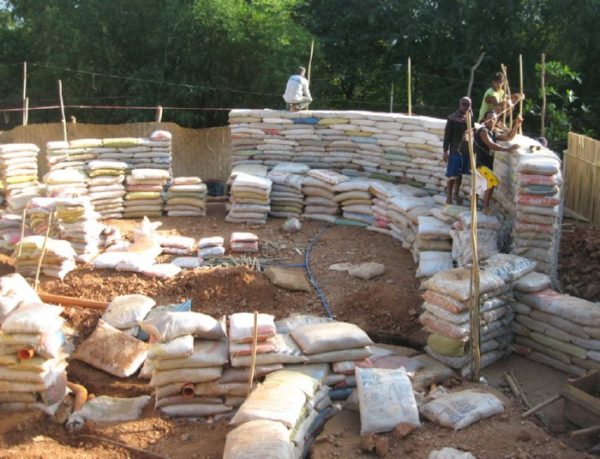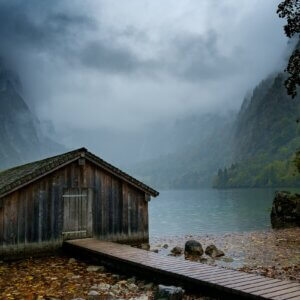What Is an Earthbag?
An “earthbag” is not a thing in and of itself. It is actually a combination of two things: a bag and dirt. These dirt-filled bags are then used like large bricks.
What Type of Bag Do I Need for Use in Earthbag Construction?

As the bags will have to stand up to some significant pressure from the dirt within them, and the weight of the wall on top of them, they need to be sufficiently strong. You can’t fill some single-use Walmart bags and expect to build a structure that is going to last for any length of time. In the realm of earthbag construction, you generally get two different camps. On the one side you have the all-natural builders that will shun the use of any synthetic material; while on the other, you have those who don’t mind using modern materials in conjunction with old. The former will generally use burlap sacks, and the latter use woven polypropylene bags.

Each type of bag has its strengths and weaknesses. The polypropylene bags are typically more easily obtained and cheaper to purchase. They are widely available online through suppliers or on sites like eBay. The most significant downside to poly bags is that they are UV sensitive. If left unprotected in the sun, they will disintegrate and weaken the wall. The burlap sacks, on the other hand, are made of natural materials — although many are treated with hydrocarbons to make them stronger. The burlap can stand up to the sun better than poly bags, but they are more prone to rot in humid climates as they are a natural plant material.
You should also be aware that there are different sizes available. In general, you are looking for bags that are around 17 inches by 30 inches. This size works well for many reasons. First, it is widely available. Second, it makes a filled bag that is easy to handle (a filled bag will weigh around 90 pounds). Finally, when assembled in the wall, this size makes a wall of a nice thickness – about 15 inches wide. Bags of other sizes have their use, but this size will be your main go-to.
What Type of Earth Do I Need for Use in Earthbag Construction?
Many natural building methods use soil as their main ingredient. From adobe to rammed earth, to earthbag and rammed tires, soil is going to be a big part of your project. When doing research on these choices, you will often hear of the “perfect” soil mixture being 70% sand and 30% clay. This makes for a strong and rock-like material once dry. For something like rammed earth or adobe where the dirt itself will have to stand on its own strength, this ratio is important. However, for methods that involve an enclosure for the dirt (whether it is a bag or a tire), you can stray a bit from this ideal ratio and still get away with it. And if your earthbags are only going to serve as infill between load-bearing members (like a timber frame), then you can stray even further from this ideal.
How Do You Build an Earthbag Home?
Building any home is a complicated process that involves many different steps, and an earthbag home is no different in this regard. In so short an article, I will not attempt an entire step-by-step guide on how to do it, but I will go over some of the general steps.

Lay a Foundation
The first step is to build the foundation. Remember that the walls that rest on this foundation will have a weight that is far greater than your normal stick-framed wall. This means the foundation also needs to be more significant than your typical foundation. It will need to be wider than usual in to spread out the increased load appropriately (this is especially true if you are in an area with soils that have poor bearing capabilities). It will also need to be thicker in order to not crack under such a load.
Most of the time, a concrete foundation of some sort will be utilized. This can be a typical concrete foundation that would be like one you find on your average home. It might be a slightly modified concrete foundation like one that rests on a tamped rubble base. Some people have even tried cement-stabilized earthbags on a rubble trench. Just know there are many choices and all have their own set of adherents and critics. Which one works for you depends on your climate and personal preference.
The final word on the foundation is to make sure that you have some way of stopping moisture from wicking up from the foundation into the wall. This is generally done using a thick plastic sheeting placed over the foundation. However, an alternative approach can also be used: The first course of the earthbag wall can be filled with gravel rather than dirt. The air spaces between the pieces of gravel within the bags prevent water from rising from the foundation into the wall above. Whatever you choose, make sure to do something as not having any barrier there will eventually weaken your wall – especially in nonarid climates.
Assemble the Walls

The first step in building an earthbag wall is to fill a bag with dirt. You will quickly find that filling a bag on the ground without any support is possible but not easy. To facilitate the process, you will want to make a bag stand that holds the bag upright, open, and in the correct location on the wall. The stand makes filling the bag much easier. Once filled to 6 inches from the top, fold over the top of the bag and put it in its place (which should be right where it was filled). Repeat this process for the entire length of the wall.

Once you have a whole row complete, you now need to tamp that row to make it hard and compact. Tamping also locks the bags together. To do the tamping, you need something heavy with a flat bottom. You can use a log that is about 5 feet long, a metal store-bought tamper, or a concrete one that you make yourself. Whatever you choose, make sure it is heavy enough to tamp well, but light enough that you can use it without tiring too quickly. Of course, the exact weight will vary according to individual strength, but an average store-bought tamper weighs about 15 pounds, so if you make your own, use 15 pounds as the standard.

Now that the first row is completely laid and tamped solid, it is time for the second row. Before placing any bags, you will need to lay down a couple strips of barbed wire along the entire length of that first row. This will help to lock the layers together as the barbs will grab on to each one. You will now do the second layer like the first. However, there are a few things to note. You will need to have something under the bag stand to prevent the bag being filled from getting stuck on the barbed wire before you want it to. Also, you must make sure to lay the bags correctly. They must be placed like bricks; every bag in the second row needs to sit on two bags from the first row. Never allow the seams to line up in consecutive rows.

You will continue as above until you reach the height of the wall desired, leaving spaces for windows and doors. This is usually done through the use of temporary wood forms that are placed in the wall. The bags are built up and around these frames and once the structure is finished, the forms are removed.
Put on a Roof

There are multiple roofing options available for an earthbag house. You could have a bond beam on top of the earthbag walls and then attach a normal roof to that bond beam. Earthbags provide you with a unique opportunity – a domed roof. On circular structures, once you have reached the desired wall height, you continue to lay layers of earthbags. Every layer comes a bit closer to the center of the circle than the last. You continue this until a dome is formed that is self-supporting and strong.
What Are Some Advantages of an Earthbag Home?
Ease of Construction – The techniques involved in earthbag construction are not all that difficult. Even without much experience, you should be able to construct a small structure with little difficulty.
All Natural – If you use burlap bags, the entire building can be constructed of natural materials. And even if you use the poly bags, only a small portion of the finished building is artificial in origin.
High Thermal Mass – Dirt is a material that has a high thermal mass. This trait makes the building itself a giant storage unit of thermal energy. It is able to absorb large amounts of energy and then release it slowly over time which helps to prevent quick temperature swings.

Cost – An earthbag structure can be built for a fraction of the cost of a traditional dwelling. This is, of course, assuming that you do the brunt of the work yourself and source the materials from around you. As the major part of your materials can be found beneath your feet, that shouldn’t be too difficult!
What Are Some Disadvantages of an Earthbag Home?
Low Insulative Value – While dirt has a high thermal mass, it has a low insulative value. This trait means that it will not prevent heat loss well. In order to function in a good portion of the country, insulation will need to be added to the exterior of the building, which can be tricky, but not impossible.

Permits, Insurance, etc. – As with all building methods that aren’t widely used, it can be tricky to get a building permit in some locales. This is a fact of life. Either go where there are no building inspectors or learn to work with the one you got. I should also mention that some insurance companies might not be willing to insure your new earthbag home, so check with them first if that is important to you.
Earthbag Home Construction Timelapse Videos
Now, it’s one thing to talk about all these features … and another to see them in action. Check out these videos of earthbag construction to show what it looks like when all these elements (and a LOT of hard work) come together to make a home.
Inspiring Photos




Books and Resources
- Books, supplies, links, lots of info: earthbagbuilding.com
- Cal-Earth focuses on researching, developing, and teaching the technologies of Superadobe. The prototypes have not only received California home permits but have also met the requirements of the United Nations High Commissioner for Refugees (UNHCR) for emergency housing. calearth.org
- Buy long bags here: calearth.org/shop
- Rubble-Bag Houses – How to: motherearthnews.com
- Earthbag Building: The Tools, Tricks and Techniques by Kaki Hunter and Donald Kiffmeyer.
Earthbag Architecture: Building Your Dream With Bags by Kelly Hart (Forward by Owen Geiger).
Building With Earth: A Guide to Flexible-Form Earthbag Construction by Paulina Wojciechowska
Polypropylene Sandbags for Sale
- Empty Beige-Tan or Green Woven Polypropylene Sandbags with BUILT-IN TIES, UV Protection; Size: 14 inches by 26 inches, 100 bags
- Sand Bags – Empty White Woven Polypropylene Sandbags with Ties, with UV Protection; size: 14 inches by 26 inches, 10 bags
- Empty White Woven Polypropylene Sandbags With UV Coating Protection, 14 inches by 27 inches, 100 bags
This article is updated from an original version by author Kieren Fox.












































Hello sir?
First of all I want to think you about all these good informations , actually I plan to build my house using earthbag technique but I’ve some questions
1- What is the minimum possible width for earthbag? I mean if i use a bag with 20CM width to give me as a result a wall like if I use normal blocks , or the thickness of wall will be not strong enough .
2- if I finish my house, and in future i want to open a new window or new door in internal or external wall can i do it ? or it will be as a risk to collapse the whole ? wall ?
3- the roof , can i use some prefabricated cement beams as the array and put the bricks between them and then the cement to create the normal roof like modern houses? Or san d bags can not hold the weight if roof!
4- ? could i build two floors with the same plan ? I mean the wall over the wall
Thanks and best regards
Tarek Elbarouni
I want to build an earthbag home in Hawaii and want to know if I can use cinder instead of sand, which is harder to come by here. Please let me know, Thanks, GReg
That’s a good question for an expert! Try Patti Stouter (simple_earth@yahoo.com) or Kelly Hart/Owen Geiger (kellyhartATgreenhomebuilding.com / strawhousesATyahoo.com – they would surely know…
Thank you for the excellent information you are providing about building with earth bags. I actually plan to build my house in Jamaica using earth bag technique. I certainly appreciate the information available on your site.
Thank you
Hello
Did you build your house using this technique?
Thank you for this information. This is something I really want to do…..soon!
Fyld dine indkøbsposer
Building of a squarre earth home in the balkans KOSOVO , around mid april 2013, the exact date will be sent via email.
Contact detail for inscription :
quranheals@hotmail.com
We are planning to develop an eco-resort. We wish to use earth-bag construction technique. Is it possible to find some Indian resource?
What wonderful work you have done here to collate all that information.
thank you so much.
Hey thanks for the pics and tips.
Doing an earthbag retreat and residence in TN, India after a lot of study of Nader Khalili and Owen Geiger’s earthbag construction.
Great work guys… all of you.. thanks a lot for the pioneering research.
Hello Dr. Amod. You can contact me if you need any help at mountainmakers.india@gmail.com.
We need more earthbaggers in India.
I have this lot near Cancun and is in the jungle, I will make a little house with earth bags, autosustainable, but can be with my design? is circular but doent want dome in roofs.
Good day, I would like to know the cost of your earth bags for a 4 bedroom 3 bathroom house combined with shipping. Also would it be possible to request a consultant in the construction of the earth bag house so as help train local workers in Indonesia.
Hello
Good day I am studying facility management, I would like to ask if earth bag construction is a intelligent building like if its fire proof, lightning proof, flood proof and earthquake proof?
Thank you.
Yes as to the structure being fire proof. Also flood resistant and capable of withstanding strong earthquakes. I would think that lightening would not strike a large mound of dirt unless absolutely nothing else around…Hope that helps…
This article was extremely informative. If I were 40 years younger, I would find a nice piece of land in B.C. Canada or rural Ontario and build myself a homestead. One could be really comfortable in one of these and it might be the right place to home school a child making them more survival savvy.
i am a volunteer looking for volunteer can help me to build such houses in Pakistan as we face flood and earthquakes every year
I have an ideal site in Romanian perfect for developing a holiday village from earthbag, looking for someone with the skills. I have plenty cheap labour and access to funds and materials. Salary negotiable. Email me on cedr2001@hotmail.com, prompt response assured.
I have rolls of 14′ & 18′ wide, UVI stabilized, woven PP tube in 6000/lf rolls for sale at great pricing. I have sold these all over the country and they are perfect for Earthbag structures. Call me at 949-338-5978 or email me for pricing.
I have rolls of 14′ & 18′ wide, UVI stabilized, woven PP tube in 6000/lf rolls for sale at great pricing. I have sold these all over the country and they are perfect for Earthbag structures. Call me at 949-338-5978 or email me for pricing.
Don’t you have anything on hyperadobe, this is similar to building with earthbags but without the barbed wire, in this system a different type of back is used with holes which does away with the need for barbed wire.
Hope to hear from you.
Don’t you have anything on hyperadobe, this is similar to building with earthbags but without the barbed wire, in this system a different type of bag is used with holes which does away with the need for barbed wire.
Hope to hear from you.
Hi Jan,
Fascinating, thanks for the explanation!
I found this page so far: http://www.earthbagbuilding.com/articles/hyperadobe.htm
And will definitely research some more. Maybe I’ll do a post on hyperadobe as well… less plastic, less wire…
Check back. Thanks! Keiren
Im trying to find earthbag friendly places in the northwest of the US with low/no building codes. Do you have any ideas?
Good day my good friend,
Let me start by introducing myself. I am a senior Staff in the department of foreign remittance as officer with Bank of Africa here in Burkina Faso West Africa.
I am writing you this letter based on the latest development at my bank which I will like to bring to your personal edification. ($15.5million) Transfer claim in to your bank account.
Pleaded, do reply for more details on how we are going to proceed if you are interested in this grateful opportunity.
Thanks
Mr. Kabiru Wahid
I live in southern Indiana US. Would this be viable for my climate zone?
Hi Russell, Sure, I think an earthbag would work in southern Indiana. But you might desire to add some insulation, either pumice or rice hulls in the bags. Or a double bag wall with insulation between. Check out this Q7A page: earthbagbuilding.com/faqs/insulmaterials.htm
can we use sea sand as a filling material in sand bag houses. And while selecting the soil, what are the properties that we consider in design
Actually almost all sea sand is rough and coarse, and therefore the grains tend to want to slide off the sharp edges of each other. Therefore the sand will tend to shift to the outside edges of the bags under weight. Smoother sand will stay in place and compress better. It is helpful to add some clay in with the sand 30/70. Subsoil, not topsoil is a good choice for earthbag building. Topsoil contains organic matter, you do not want this. I do not understand the second part of your question…
I spent 30 years learning applied building science in Ohio and elsewhere by working in low income Weatherization, and never knew about this intriguing housing type. One forum that promote smart housing is the Affordable Comfort Conference, hosted by ACI, that brings together 2000-plus housing pro’s from many fields. Consider presenting and attending. Check them out at http://www.affordablecomfort.org
hello
Is it possible to mix the clay in the earthbags also with plastic rubbish?
I am living on a island, no garbage service and love to ged rid also from plastic in a recycling way. So i wonder if building with earthbags, plastic (small plastic rubbish on the beaches etc) can be mixed?
Just spoke to a very helpful chap in South Africa who is very knowledgeable about sandbag building.
What’s nice is that the structures he builds look exactly like a normal house.
Look him up on his website ecobuilders.co.za
I like this idea, but does anyone have any experience of building these in a zone infested with termites?
We are trying to build are house right know for are four children and are doing it using cob to save money, we have land in Texas that we are building on. What can we do for cooling and Windows, and how thick does the cob have to be.
Need some instruction on how to go about building such a house. Where to go?
Please check out the permies.com forum on earthbag building…so much info there and so many who can definitely answer your questions!
permies.com/forums/f-79/earth-bag
I am interested to learn more about build house by sandbages I want viste any cite in California
planning on building me one of these in kentucky,how would the climate be for one in this region of the country
Hello family,
I would like to know where are/were this projects going on!! Im a free traveler seeking for volunteer in such kind of projects in order to improve my skilss as ecobuilder. For that reason I would love to know the epicenter of such happenings…
Looking forward to hear from you
Namaste
Love it, thought about this 40 years ago, need a how to video.
Hi, I would like to ask if there are projects conducted by TOP NOTCH Construction ? You mentioned some in PH. thanks
Hello everyone, we are looking for volunteers to help build a school in rural East Africa using earth bags. Please reply if you or anybody you know can be of help. We are ready to provide accommodation to the volunteers. Email to: st.speciozahome@gmail.com
Thanks
I will be doing earthbag school in Kenya shortly and will want to share ideas
I love your concept of building with plastic bags. If the technique could become tested to comply with modern building guidelines, also withstanding that it could take all kind of weathers, including arctic winters, then this techinque should become widespread!
It seems as the easiest way I’ve ever seen.
Really creative and sustainable idea for vast requirement of dwelling units for Rural India, ‘Locally available material with Local construction technology, with people. Eco friendly and can accommodate modern facility.
This technology should be spread to as many people as possible. India should have similar institute or branch.
i am willing to help in all possible manner. feel free to contact me.
Hi there,
I’m looking for a volunteer job in SE Asia. I can start somewhere in May.
Who knows a nice project?
estamos diseñando una ecoaldea y no logramos calcular el mt2 de construcción con la obra blanca económica. si nos pudieran colaborar se lo agradeceriamos inmensamente.
cordialmente
scar Giraldo
Depending on the dirt’s microbe composition, plastic bags break down in years or a few decades. Since dirt has no real compressive or tensile strength what happens then?
Hi Paul,
Most of the earthbag structures use polypropylene sandbags. If exposed to sunlight they can break down pretty quickly, though on our project we purchased UV protected bags that were able to withstand about a year of direct exposure. However, once covered up in darkness there’s no breakdown, at least not in terms of a few years or decades. Further, the material inside the bags isn’t typically just dirt – it’s ideally a clay-heavy fill dirt mixed evenly with an aggregate. That combination is fairly sturdy so long as it’s kept dry.
I am looking for a builder for a sandbag studio in Los angeles
How Ironic, I was just thinking about Earth bag houses earlier! 😀 Q, I am wanting to do an Earthbag in April, can they be done for about $300, ( I saw a cob house done for that price), and, does Earthbags do well in rain? I live in NC, where we have all 4 seasons, with snow. We also have ice storms. And wind storms. What would you suggest??
Hi Ashley – cost totally depends on scope. If you don’t have to pay for clay-heavy soil or aggregate gravel to actually fill the bags, then Earthbags are pretty affordable. $300… maybe so maybe not. But you’re not gonna spend $10k on it unless you’re paying for fill material, or lots of labor, or you’re making the structure huge.
Earthbags can handle rain but will depend on what you cover them with. If you cover them with cob, then you’ll need to give the a “good hat and boots” like any cob structure to protect the walls from wind and rain. If you cover the walls with a cement stucco, it’s more expensive and less eco-friendly, but can handle the elements with less maintenance.